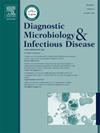Evaluating clinical outcome in non-HIV associated cryptococcal meningitis with negative CSF culture using microscopic quantitative cryptococcal counting
IF 2.1
4区 医学
Q3 INFECTIOUS DISEASES
Diagnostic microbiology and infectious disease
Pub Date : 2025-06-06
DOI:10.1016/j.diagmicrobio.2025.116944
引用次数: 0
Abstract
Background
Non-HIV associated cryptococcal meningitis (CM) patients with negative cerebrospinal fluid (CSF) culture lack validated biomarkers for outcome assessment. Baseline CSF cryptococcal count via India ink staining correlate with disease progression, but the role of cryptococcal clearance rate remains unclear in this population.
Methods
We retrospectively collected data from 594 non-HIV associated CM patients from the Third Affiliated Hospital of Sun Yat-sen University. 111 non-HIV associated CM patients with negative CSF culture were included to analyse. We focused on analyzing the association between cryptococcal clearance rate and outcome.
Result
Baseline high log10 CSF cryptococcal count (OR: 2.939, 95%CI 1.574-5.488, p=0.001) and slow rate of cryptococcal clearance (OR: 92.228, 95%CI 6.453-1318.128, p=0.001) were associated with unsuccessful outcomes at 2 weeks after admission. The baseline high log10 CSF cryptococcal count (OR: 1.520, 95%CI 1.045-2.211, p=0.029), slow rate of cryptococcal clearance (OR: 162.896, 95%CI 10.028-2646.031, p=0.001) and hearing impairment at baseline (OR: 8.683, 95%CI 1.294-58.291, p=0.026) were associated with unsuccessful outcomes at 10 weeks after admission. And hearing impairment at baseline (log-rank test, p=0.007), baseline log10 CSF cryptococcal count ≥1.52/ml (log-rank test, p=0.033) were associated with no clinical cure within 1 year after admission.
Conclusion
Rate of cryptococcal clearance based on India ink staining may be a marker for short-term outcomes in non-HIV associated CM patients with negative CSF culture. Monitoring this marker may optimize clinical management in this challenging subgroup. Notably, its strengthened association at 10 weeks reflects sustained prognostic value, while the attenuated effect of baseline count suggests diminishing early impact.
使用显微定量隐球菌计数评估脑脊液培养阴性的非hiv相关隐球菌脑膜炎的临床结果
背景:脑脊液(CSF)培养阴性的非hiv相关隐球菌脑膜炎(CM)患者缺乏有效的生物标志物来评估结果。通过印墨染色的基线CSF隐球菌计数与疾病进展相关,但隐球菌清除率在该人群中的作用尚不清楚。方法回顾性收集中山大学第三附属医院594例非hiv相关CM患者的资料,其中111例脑脊液培养阴性的非hiv相关CM患者进行分析。我们重点分析隐球菌清除率与预后之间的关系。结果基线时高log10脑脊液隐球菌计数(OR: 2.939, 95%CI为1.574-5.488,p=0.001)和低隐球菌清除率(OR: 92.228, 95%CI为6.453-1318.128,p=0.001)与入院后2周预后不理想相关。基线时高log10脑脊液隐球菌计数(OR: 1.520, 95%CI 1.045-2.211, p=0.029)、低隐球菌清除率(OR: 162.896, 95%CI 10.028-2646.031, p=0.001)和基线时听力障碍(OR: 8.683, 95%CI 1.294-58.291, p=0.026)与入院后10周不成功的结果相关。基线听力障碍(log-rank检验,p=0.007)、基线log10 CSF隐球菌计数≥1.52/ml (log-rank检验,p=0.033)与入院后1年内无临床治愈相关。结论印墨染色隐球菌清除率可作为脑脊液培养阴性的非hiv相关CM患者短期预后的指标。监测这一标志物可以优化这一具有挑战性的亚组的临床管理。值得注意的是,其在10周时的强化关联反映了持续的预后价值,而基线计数的减弱作用表明早期影响减弱。
本文章由计算机程序翻译,如有差异,请以英文原文为准。
求助全文
约1分钟内获得全文
求助全文
来源期刊
CiteScore
5.30
自引率
3.40%
发文量
149
审稿时长
56 days
期刊介绍:
Diagnostic Microbiology and Infectious Disease keeps you informed of the latest developments in clinical microbiology and the diagnosis and treatment of infectious diseases. Packed with rigorously peer-reviewed articles and studies in bacteriology, immunology, immunoserology, infectious diseases, mycology, parasitology, and virology, the journal examines new procedures, unusual cases, controversial issues, and important new literature. Diagnostic Microbiology and Infectious Disease distinguished independent editorial board, consisting of experts from many medical specialties, ensures you extensive and authoritative coverage.

 求助内容:
求助内容: 应助结果提醒方式:
应助结果提醒方式:


